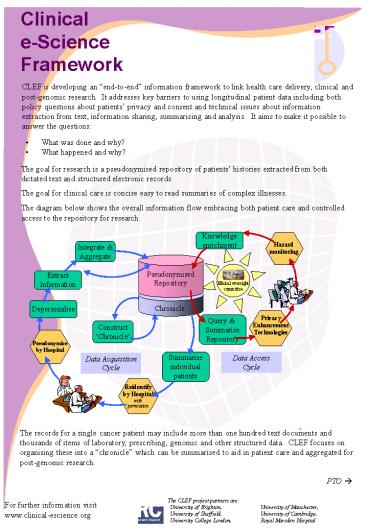CLEF is developing an endtoend information framework to link health care delivery, clinical and post PowerPoint PPT Presentation
1 / 2
Title: CLEF is developing an endtoend information framework to link health care delivery, clinical and post
1
Clinicale-ScienceFramework
CLEF is developing an end-to-end information
framework to link health care delivery, clinical
and post-genomic research. It addresses key
barriers to using longitudinal patient data
including both policy questions about patients
privacy and consent and technical issues about
information extraction from text, information
sharing, summarising and analysis. It aims to
make it possible to answer the questions
- What was done and why?
- What happened and why?
The goal for research is a pseudonymised
repository of patients histories extracted from
both dictated text and structured electronic
records. The goal for clinical care is concise
easy to read summaries of complex illnesses. The
diagram below shows the overall information flow
embracing both patient care and controlled access
to the repository for research.
The records for a single cancer patient may
include more than one hundred text documents and
thousands of items of laboratory, prescribing,
genomic and other structured data. CLEF focuses
on organising these into a chronicle which can
be summarised to aid in patient care and
aggregated for post-genomic research.
PTO ?
The CLEF project partners are University of
Brighton, University of Sheffield,
University College London,
For further information visit www.clinical-escienc
e.org
University of Manchester, University of
Cambridge, Royal Marsden Hospital
2
Clinicale-ScienceFramework
A graphical view of the CLEF chronicle is
illustrated below. The information required is
drawn from many different documents extending
over the entire course of the patients history
and is built up gradually as information becomes
available.
To make the information in the repository easily
available to researchers, CLEF uses a technique
of query refinement called WYSIWYM what you
see is what you meant.
Query Treatment profiles Patients who received
this type of treatment, compared with patients
who did not. Outcome measure Percentage of
patients alive after this interval of
time. Relevant subjects Patients with this
type of cancer Answer It was found that out
of 1790 patients diagnosed with cancer of the
pancreas, 1300 had a pancreaticoduodenectomy and
490 didnt. Out of the 1300 patients who had a
pancreaticoduodenectomy, 890 (68.46) were alive
after 5 years. Out of the 490 patients who did
not have a pancreaticoduodenectomy, 87 (17.75)
were alive after 5 years.
Information extraction from text, the formulation
of chronicles and summaries, and the WYSIWYM
interface are all knowledge intensive. CLEF
works with myGrid and other E-Science
projects on developing standards and tools for
knowledge sharing, metadata, provenance, and
workflow management. It aims to use the results
of the E-Science programme to contribute to a
comprehensive environment for post genomic
research E-Health.
The CLEF project partners are University of
Brighton, University of Sheffield,
University College London,
For further information visit www.clinical-escienc
e.org
University of Manchester, University of
Cambridge, Royal Marsden Hospital

